 The Phase Change Matters e-mail newsletter is a weekly summary of the latest news and research on phase change materials and thermal energy storage. To subscribe, visit www.puretemp.com/subscribe. For more frequent updates, follow @puretemp on Twitter or visit the Phase Change Matters blog, www.puretemp.com/pcmatters.
The Phase Change Matters e-mail newsletter is a weekly summary of the latest news and research on phase change materials and thermal energy storage. To subscribe, visit www.puretemp.com/subscribe. For more frequent updates, follow @puretemp on Twitter or visit the Phase Change Matters blog, www.puretemp.com/pcmatters.
HVAC
PCM-equipped personal air conditioner set for commercial release in 2019
Developers of a personal air conditioner designed to reduce energy use in office buildings say they’re on track for commercial release next year. The “μX” micro climate system features a phase change material that solidifies at about 18 degrees C to store cooling generated at night for use during the day.
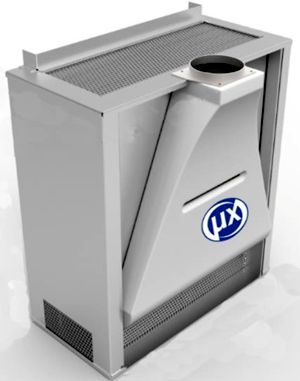 The evolution of the μX: an early design … |
Sam Brown, OEM custom director at Air Innovations, is in charge of bringing the product to market. He and Michael Wetzel, president and CEO at Air Innovations, talked about their company’s role in the project.
Q: Describe the μX system size, components and functionality.
Brown: “The current unit is about twice size of a standard PC computer tower. The unit utilizes a phase change material that melts over time. We then run a fan over the material to create an active cooling effect. A compressor then re-solidifies the PCM in the off-peak hours for future on-demand needs.”
Q: Describe the phase change material used in the system: type, melt point, thermal storage capacity, amount used in each unit.
Brown: “Rubitherm, 68F, 8-10 hours, 40 pounds.”
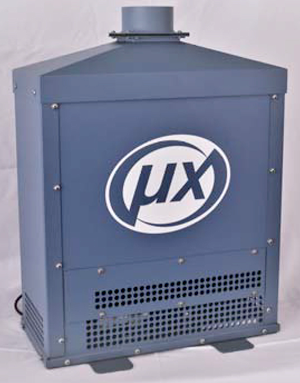 … a version displayed at a recent conference … |
Wetzel: “Many PCMs were considered and analyzed before settling on Rubitherm, but no others were tested in operating systems.”
Q: Preliminary tests indicate the prototype can remove more than 32W of heat, surpassing the ARPA-E grant target of 23W. Is the final production model likely to hit that higher number?
Wetzel: “23 watts is the target heat removal directly from a person. Our manikin results showed us exceeding that number in all tests. We tested three different diffuser methods. Some achieved as high as 32 watts removed from the manikin. In all cases we are actually generating more than 500 watt-hours of cooling, enough to cool the airstream 8 degrees F for 10 hours.”
Q: The system is now known as “μX.” Will that name be used for the commercial product?
Brown: “No, the commercialized name will more closely reflect the manner in which it’s utilized.”
Q: What was the greatest technical hurdle the team faced in developing this product?
Wetzel: “There were many challenges on this project. Part of the program required the development of the world’s smallest scroll compressor. This also means that there was no performance data or design simulation data with which to develop the rest of the system. Our partners on the project had to develop simulation tools based on testing each new component. At Air Innovations our main challenges are designing for manufacturability and the integration and testing of off-the-shelf components as alternatives, as some of the elements of the ARPA-E units are not yet commercially available.”
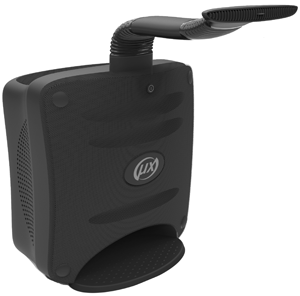 … and, finally, says Brown, “where we think the unit will potentially go in final production.” |
Brown: “Currently, we are working through ARPA-E and New York State Energy grants to fully develop the technology. We are developing the unit for two scenarios. The primary is for 8-10 hours of cooling in any office environment. The other is for four hours to off-load the grid in metropolitan areas with peak power capacity concerns. Several units have been built and tested in controlled environments. We are currently seeking grant opportunities to support larger field trials.”
Q: Can you offer any details on the timeline, projected price, target market and sales projections?
Brown: “Further human testing will be necessary in order to right-size the final product. The unit will likely be ready for market sometime in 2019. The initial price point of the unit will be higher, and then come down based on quantity and market demand, settling around $2,500. It is our goal to bring to market 250-500 units in the first year.
“The exciting opportunity with the μX technology is that it further expands upon our existing Micro Environments product line. The commercialized unit will be able to control the users’ complete environment while not only offering active cooling and heating, but to control their entire surroundings as seen in our other models. Furthermore, our customers will see an ROI with the μX technology by allowing set points in the summer to run higher and temps to run cooler in the winter, reducing building HVAC power needs with a more personal temperature control directly at the desk. We believe this technology can improve worker productivity by allowing individual control, at all times, of their specific environment.”
PATENTS
Heat exchanging thermal liquid container
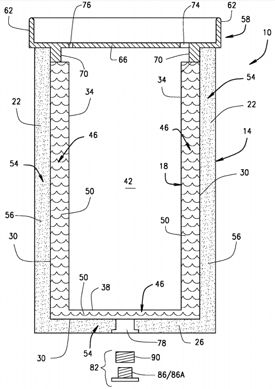 U.S. patent application 20180171197 (assignee Curators of the University of Missouri, Columbia, Mo.):
U.S. patent application 20180171197 (assignee Curators of the University of Missouri, Columbia, Mo.):
“A heat exchanging thermal liquid container system that comprises a main body at least partially defining a liquid reservoir structured and operable to retain a liquid, and a phase change material (PCM) liner comprising a PCM liner PCM having a selected melting temperature, and/or at least one PCM pod. Each of the at least one PCM pod(s) comprising a respective PCM pod PCM having a respective selected melting temperature. Wherein the PCM liner and/or the at least one PCM pod are disposable within the liquid reservoir such that when a liquid is disposed within the liquid reservoir the liquid will contact at least one of the PCM liner and the at least one PCM pod such that thermal energy can be exchanged between the liquid and the respective at least one of the PCM liner PCM and the at least one PCM pod PCM.”
Related: Drinkware and plateware and active temperature control module for same (Ember Technologies Inc.)
Protective headgear comprising temperature control apparatus
U.S. patent application 20180160761 (applicant Aspire Zone Foundation, Doha, Qatar):
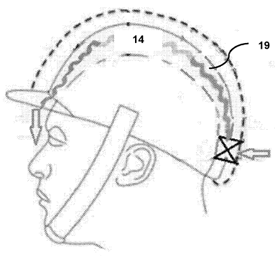 “A protective headgear, such as a hard hat, is provided that comprises a protective outer shell, which surrounds the head of a wearer and in so doing defines a space between the head of the wearer and the underside of the outer shell; a heat-absorbing member; and a forced air ventilation apparatus. In use, the heat-absorbing member is positioned within the outer shell in the space formed between the head of the wearer and the outer shell, so that the forced air ventilation apparatus can provide a flow of ambient air from outside of the outer shell over the heat-absorbing pad within the space between the head of the wearer and the underside of the outer shell, thereby creating a cooling circulation of air around the head and face of the wearer. Suitably, the heat-absorbing pad comprises a phase-change material (PCM).”
“A protective headgear, such as a hard hat, is provided that comprises a protective outer shell, which surrounds the head of a wearer and in so doing defines a space between the head of the wearer and the underside of the outer shell; a heat-absorbing member; and a forced air ventilation apparatus. In use, the heat-absorbing member is positioned within the outer shell in the space formed between the head of the wearer and the outer shell, so that the forced air ventilation apparatus can provide a flow of ambient air from outside of the outer shell over the heat-absorbing pad within the space between the head of the wearer and the underside of the outer shell, thereby creating a cooling circulation of air around the head and face of the wearer. Suitably, the heat-absorbing pad comprises a phase-change material (PCM).”
IN BRIEF
• A new neck collar designed for people living with motor neurone disease features Outlast phase change technology to keep the wearer cool. The Heads Up collar supports the collection of small muscles in the neck that are vulnerable to the wasting effects of the disease.
• A Northwestern University team has developed a thermally responsive bandage that quickly heals painful, hard-to-treat sores in people with diabetes. The bandage features a hydrogel that rapidly solidifies when exposed to body temperature, conforming to the shape of the wound.
• In the short term, analysts say crude palm oil prices have likely hit rock bottom. But a Rabobank analyst is projecting reduced production – and higher prices – from 2022 to 2025.
• A call for papers has been issued for the Advanced Automotive Battery Conference Europe, to be held in Strasbourg, France, Jan. 27-31, 2019. “Thermal modeling” and “preventing thermal runaway” are among the topics. The deadline for priority consideration is June 29.
• Emily Liu, a professor at Rensselaer Polytechnic Institute, was recently selected by the U.S. Department of Energy’s Solar Energy Technologies Office to receive a $1.8 million award to study high-temperature molten-salt properties and corrosion mechanisms.
• Dr. Robert Brookins, interim CEO at Alexium International Group Ltd., will present an hourlong webinar, “Phase Change Materials: How Can They Help Set Your Company Apart,” on June 28. The free event is sponsored by the Industrial Fabrics Association International.
• Swedish solar company Azelio has launched a demonstrator of its solar energy storage technology. The system uses an aluminum alloy as a thermal storage material.
• In a new directive, the European Commission is calling for at least 32 percent of total EU energy use to come from renewable sources by 2030. The directive, which will require the formal approval of the European Parliament, sets specific annual targets for cooling and heating installations.
• The agenda is taking shape for the 13th International Conference on Advanced Building Skins, to be held Oct. 1-2 in Bern, Switzerland. Topics include “Energy buffering with phase change materials” and “Thermal performance of phase change materials for the building skin.”
• Va-Q-tec AG is expanding its Kölleda location in Thuringia, Germany. The company manufactures vacuum isolation panels, phase change materials and passive thermal packaging systems at two plants there.
• MIT Technology Review reports that Alphabet Inc. (Google‘s parent company) appears to be in talks to spin out Project Malta, a molten-salt energy storage project, in a transaction involving Breakthrough Energy Ventures, Bill Gates’ $1 billion investment fund.
RESEARCH ROUNDUP
For our full list of recent academic research, see puretemp.com/academic. Here are highlights from the past week:
From Energy Conversion and Management:• Effect of using nanoparticles on the performance of thermal energy storage of phase change material coupled with air-conditioning unit
• Numerical study on the effect of non-uniform magnetic fields on melting and solidification characteristics of NEPCMs in an annulus enclosure
• Solidification behavior of binary eutectic phase change material in a vertical finned thermal storage system dispersed with graphene nano-plates
From International Communications in Heat and Mass Transfer:
• A method to evaluate natural convection heat transfer in microencapsulated phase change material (MPCM) slurry: An experimental study
• Dynamic of plumes and scaling during the melting of a Phase Change Material heated from below
From Applied Thermal Engineering:
• Experimental investigation of the thermal performance of heat pipe assisted phase change material for battery thermal management system
• Low-temperature macro-encapsulated phase change material based thermal energy storage system without air void space design
From Energy and Buildings:
• Modeling and experimental validation of an algorithm for simulation of hysteresis effects in phase change materials for building components
• Thermal performance and numerical simulation of geopolymer concrete containing different types of thermoregulating materials for passive building applications
From Solar Energy:
• How to enhance thermal energy storage effect of PCM in roofs with varying solar reflectance: Experimental and numerical assessment of a new roof system for passive cooling in different climate conditions
From Energy:
• A facile approach to synthesize microencapsulated phase change materials embedded with silver nanoparticle for both thermal energy storage and antimicrobial purpose
From Reference Module in Materials Science and Materials Engineering:
• Materials, Design and Development of Latent Heat Storage Systems for Medium and Large-Scale Applications: Issues and Challenges
From Physica A: Statistical Mechanics and its Applications:
• Melting process in porous media around two hot cylinders: Numerical study using the lattice Boltzmann method
From Solar Energy Materials and Solar Cells:
• Synthesis and characterization of chain-extended and branched polyurethane copolymers as form stable phase change materials for solar thermal conversion storage
From Construction and Building Materials:
• Investigation of different materials for macroencapsulation of salt hydrate phase change materials for building purposes
From Journal of Energy Storage:
• CFD thermal energy storage enhancement of PCM filling a cylindrical cavity equipped with submerged heating sources
• Performance analysis of industrial PCM heat storage lab prototype
NETWORKING
Connect with PCM experts and industry leaders on LinkedIn
 More than 1,250 people have joined a LinkedIn group devoted to the discussion of phase change material and thermal energy storage. The Phase Change Matters group is an interactive complement to the award-winning blog and newsletter of the same name.
More than 1,250 people have joined a LinkedIn group devoted to the discussion of phase change material and thermal energy storage. The Phase Change Matters group is an interactive complement to the award-winning blog and newsletter of the same name.
You are invited to join the group and connect with PCM and TES experts from around the world. This week we welcome Jonas Hagman, vice president at Perstorp Group‘s Penta unit, Helsingborg, Sweden; Yanming Wei, CEO at Kiwaho Lab of Energy & Ecology Inc., Ottawa, Canada; Jan-Willem Schmid, cost expert at Heijmans Utiliteit, Rosmalen, Netherlands; Dawn Smith, associate director of R&D at Cold Chain Technologies, Franklin, Mass.; and Fábio Libardi Noronha, mechanical engineer, Vila Velha, Brazil. Fábio writes:
“I am founder of a startup in Brazil called SUNFLEX. We work with innovative projects for renewable energy efficiency improvements. One of our projects is related to PCM applied to solar energy systems.”